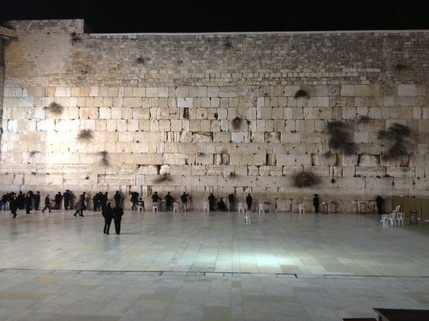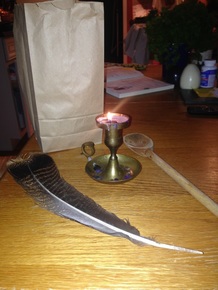
In June of 1995, I got on an airplane to travel to Israel for the very first time in my life. I had been accepted into the rabbinic program of Hebrew Union College, and, with no small amount of trepidation, I was traveling a third of the way around the world to begin my studies and to live in the land of my ancestors.
Sitting at my side on that plane was my new bride. Jonquil and I had been married for just over a month when we left Somerville, Massachusetts. Most of our possessions – including most of our wedding gifts, still in their boxes – were deposited in a storage unit in Acton, Massachusetts. We would not be seeing them again for a year when we would come back to the United States for my second year of rabbinic school in New York City. We were putting our lives on hold just as we were beginning our new lives as a married couple.
As we flew over Europe, I took out a ball point pen and the blank book that I had purchased to record my thoughts and observations during the year in Israel. I opened the book to the first page and began my first entry. I wanted to record the expectations and hopes I was experiencing on that flight.
Looking back at that journal today, twenty years later, I am surprised by what I wrote. I said nothing about my anxieties about starting a demanding academic program nearly a decade after I had last sat in a classroom. I wrote nothing about the difficulties of finding my way through an unfamiliar culture where even the toddlers spoke the language better than I did. I didn’t even write about the challenges that Jonquil and I would face spending our honeymoon year so far away from family and friends. (In retrospect, I should have thought about that more).
What I did write about was a Wall. I wrote about the expectations and anticipation of standing for the first time in front of a two-thousand-year-old Wall in the heart of Jerusalem. I thought about what it would mean to me to be in the presence of that Wall. I thought about what I would say to that Wall.
Here is what I wrote in my journal twenty years ago:
Is that huge piece of stone really ‘the most holy place in the world’? I have come to believe that God and revelation are, essentially, internal experiences. The God who is worthy of praise, I believe, lives within our hearts, within our own best aspirations for ourselves, for our communities and for our world. The God in whom I find comfort is the idea of redemption, a hope and an ideal cherished within the human soul.
But then, there is this Wall. It is sacred, huge and, it seems, unrelentingly material and external. The Wall seems to challenge me, saying, "Come to terms with me. I don’t just represent the sacred, like your candles and wine. I am the thing itself – remnant of the Temple, God’s place on earth. You cannot swallow me. You cannot convince yourself that I am just an idea or an aspiration. I am tons and tons of ancient rock. I am here."
That Wall – the Western Wall – is as real as anything you can imagine. Let me tell you a bit of its story.
The Western Wall is a portion of the retaining wall that King Herod the Great built in Jerusalem in the first century B.C.E. as the platform for Israel’s holy Temple. Upon this platform, called the Temple Mount, Herod rebuilt the Temple and made it one of the greatest architectural marvels of the Roman Empire.
Herod’s Temple, though, only lasted for less than a century. The Romans destroyed it in the year 70 CE during the Great Revolt. Today, not even a single stone stands to mark the walls of the Temple itself. Only the retaining wall remains to support the 37 acres of the Temple Mount. It has been repaired and rebuilt many times over the centuries, but one can still discern the stones, hewn in the Roman style, that are part of the original retaining wall.
Although the retaining wall around the Temple Mount is nearly a mile in circumference, only a small portion of it – the portion that is closest to where the Temple stood – is accorded the holiest status in Jewish tradition. That is the Western Wall – the 187-foot-long section that Jews have considered the holiest place on earth since antiquity. For Jews, it is the center of the universe, the place where heaven and earth meet.
According to rabbinic legends, it was from the grounds of the Temple Mount that God collected the dust to create the first human being. The Temple Mount is associated with Mount Moriah in the book of Genesis, the place where Abraham nearly sacrificed his son Isaac.
The Temple Mount is also the direction of prayer in Judaism. According to the Talmud, while praying anywhere in the world, one should pray in the direction of Jerusalem. While in Jerusalem, one should pray in the direction of the Temple. When in the vicinity of the Temple, one should pray in the direction of the Holy of Holies, which stood directly above the Western Wall.
The Roman destruction in the year 70 – of not only the Temple, but the entire city of Jerusalem – was nearly complete. The city was left abandoned and uninhabitable for 65 years. In 135, the Roman Emperor Hadrian rebuilt Jerusalem, renaming it Aelia Capitolina and dedicating it to the Roman god Jupiter. He banned all circumcised men from entering the city on pain of death. For more than 200 years, there was no Jewish presence in the city and no one to weep for Jerusalem at the site of the Temple.
In 363, Jews began to return to Jerusalem. There, they identified a small exposed section of the Temple Mount retaining wall as a place of special holiness. They called it HaKotel HaMa’aravi, the Western Wall. Jews stood before the Wall to mourn the destruction of the Temple. That is why the Wall was called el-Mabka by the Arabs, “The Place of Weeping,” and translated into English and other languages as the “Wailing Wall.” But, for Jews, it remains the Western Wall.
While there were various attempts by Romans, Christians and Jews to build temples and churches on the top of the Temple Mount during the second through sixth centuries, the structures that stand there today are all Muslim. The Al-Aqsa Mosque built on the southern edge of the Temple Mount in the early 7th century is considered by Muslims to be the third holiest place in the world, after the holy cities of Mecca and Medina. Later in the 7th century, Muslims built the Dome of the Rock, the octagonal shrine that now has a golden dome, directly on the spot where the ancient Israelite temples stood, directly above the Western Wall.
This week, we celebrate the sixty-seventh birthday of the founding of the State of Israel. Yom HaZikaron, Israeli Memorial Day, was this past Tuesday. It is the day that Israel remembers those members of the Israeli armed forces who have fallen in the defense of Israel and the victims of terrorism in Israel. Yom Ha’atzma’ut, Israeli Independence Day, was Wednesday. It is the day that Israel, and Jews everywhere, rejoice in the founding of the State of Israel in 1948.
But that date, 1948, also marks the time when the Kingdom of Jordan took control of the Western Wall. Like the Romans before them, the Jordanians banned Jews from visiting the site. Again, it sat abandoned, guarded over by soldiers of a foreign nation.
It was not until nineteen years later, with the Six Day War, that Israel took the Old City and the Western Wall back from Jordan. Three weeks from Sunday, we will remember that moment, too, with Yom Yerushalayim, Jerusalem Day, the anniversary of the reunification of Jerusalem in 1967. Since that time, Israel has assured that Jews can pray at the Western Wall and Muslims can pray at the Dome of the Rock and the Al Aqsa Mosque. Also in the Old City, not far from the Temple Mount, the Church of the Holy Sepulcher is governed by authority of several Christian denominations and all are free to visit. Respect for the sacred places of all religions has returned to the Land of Israel.
Well…mostly. You probably know that the control of the Western Wall is still a contentious issue in Israel. The Wall today operates as an Orthodox synagogue. There are rules about the ways one may pray there. There are rules to keep men and women apart. There are rules that prevent women from reading from the Torah at the Wall, even in the area designated for women.
That may be changing. The group, Women of the Wall, has challenged the orthodox hegemony at the Western Wall. They have won battles in Israel’s courts to affirm their right to worship there as Jews. This past week, a group of women read from a full-size Torah at the Western Wall for the first time since it came under the control of the Orthodox establishment. There are more battles to be fought to make the Wall the equal possession of every Jew.
Twenty years after I first wrote in my journal on my way to Israel, I still think about the difficulty of coming to terms with this holy, contentious, and unnerving Wall. The Wall reminds me that Judaism is not just an idea, a philosophy, or even just a religion. The Land of Israel, the holy city of Jerusalem within it, and the Western Wall within the city, are all reminders that Judaism is about deep, physical, material reality. Judaism is a belief, but it is also a history of a people that is filled with moments of triumph and tragedy. Judaism is a way of thinking, but it is also a way of living and belonging that is as concrete as ancient stones chiseled by human hands.
We are privileged to live at a time when the Jewish people have sovereignty in their own land for the first time in more than 2,000 years, but we also are challenged by that reality. The Jewish men and women who fought for the Land of Israel did so in order to keep Torah alive, but they also did so to keep Jews alive. That struggle has not ended. Our relationship with Israel needs to be spiritual and aspirational, but it also needs to be material and real.
My first taste of that struggle happened a few days after I wrote those words in my journal at 30,000 feet. Two days after I landed at Ben Gurion Airport for the first time, I stood in front of the Wall and touched her stones. I listened to the people around me murmuring their prayers and I listened to the sound of the wind stirring through the plaza. I did not feel like I really knew the Wall, but Jonquil encouraged me not to try to know it, but just to listen to it. Its voice is deep and quiet. I found that, indeed, I could not swallow it. I could not idealize it.
To my surprise, I found that the Wall could swallow me. I found that I am more a part of it than it is a part of me. It is still speaking to me, and I am still trying to hear it.
Shabbat shalom.
Other Posts on this Topic:
Sign at the Entrance to the Western Wall
Women of the Wall


 RSS Feed
RSS Feed
